#porsche 70 years
Text
Porsche Car Quotes by Car Admirers
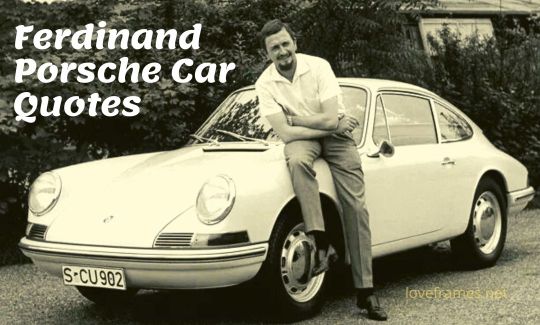
Porsche Car Quotes
…there is no substitute – Ferdinand Porsche
You still owe me a yellow Porsche. – Stephenie Meyer
Porsche and BMW drivers are arrogant. – Carroll Shelby. Porsche car quotes
Fast cars like Porsches and Ferraris – they are things of beauty. – Rod Stewart
Driving a Porsche in London is like bringing a Ming vase to a football game. – Douglas Adams
It was fun to blow off a Porsche with a 3900 donkey [the 1965 Shelby GT350 Mustang]. – Carroll Shelby
Oh, Lord, won’t you buy me a Mercedes Benz – My friends all drive Porsches, I must make amends. – Janis Joplin. Porsche car quotes
If you take off your pants and her first reaction is, “Awwww, look at it…like a little baby Jesus.” Time to buy a Porsche. – Dave Attell. Porsche car quotes
Apple’s market share is bigger than BMW’s or Mercedes’s or Porsche’s in the automotive market. What’s wrong with being a BMW or Mercedes? – Steve Jobs
Long Porsche Car Quotes
Like, what is the least often heard sentence in the English language? That would be: Say, isn’t that the banjo player’s Porsche parked outside? – Jackson Browne
Screw reality. It don’t feed my dog. It don’t make my Porsche payments. It don’t get me laid. Bullshit does that…and I like it that way. (Leo). – Sherrilyn Kenyon
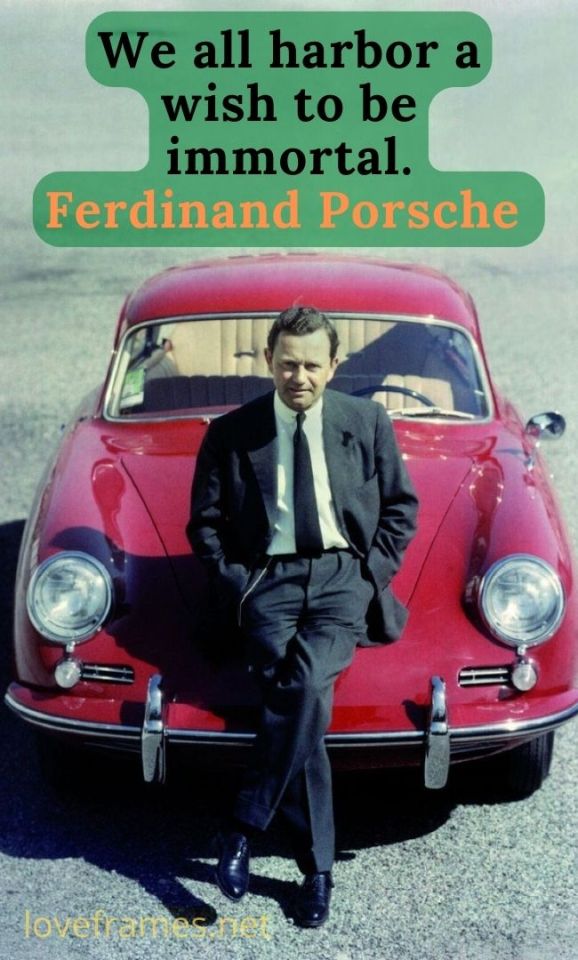
I’ve learned to feel good when I feel good. It’s better to be driven around in a red Porsche than to own one. the luck of the fool is inviolate. – Charles Bukowski. Porsche car quotes
I have every single Ferrari that came out. I have all the Mercedes they came out with, all the Jaguars they came out with, all the Porsches they came out with. – Ion Tiriac. Porsche car quotes
I’m sorry about your Porsche.” “I can replace the Porsche. I can’t replace you. You need to be more careful.” I was just sitting in your car!” Babe, you’re a magnet for disaster. – Janet Evanovich
Wasn’t it his right to listen to opera, read poetry and adventure novels, go to Europe every couple of months for some reason or another, and drive his Porsche over the speed limit until he found out who he was? – Anne Rice
And I’m more sure than in Poland, or elsewhere, it is considered cool to drive a Porsche and wear necklaces and black silk, but at least back in Brooklyn if you did those things you were either a drug dealer or from New Jersey. – Meg Cabot
Growing up in the Midwest, people didn’t drive Porsches and Ferraris. They drive Fords and Chevys. And so even if you have the opportunity to buy a more expensive car, it doesn’t occur to you because it’s not what you relate to. – Luke Perry
Porsche Car Quotes by Ferdinand Porsche
Cars are my life. – Porsche car quotes
Good design should be honest. – Ferdinand Porsche.
Timeless design is wasted if it cannot survive. – Ferdinand Porsche.
To create something timeless. – Ferdinand Porsche. Porsche car quotes
We all harbor a wish to be immortal. – Ferdinand Porsche. Porsche car quotes
Famous Ferdinand Porsche Quotes
I believe that creativity should not be suppressed. – Ferdinand Porsche.
I came into the world at the same time as the auto, if you will. – Ferdinand Porsche.
A car with good accelerating power will automatically give me a high speed performance. – Ferdinand Porsche.
I myself have never attempted to actively build my own profile but rather continued in my father’s image. – Ferdinand Porsche.
In the beginning I looked around and, not finding the automobile of my dreams, decided to build it myself. – Ferdinand Porsche.
I took a different approach and improved its performance by radically reducing its weight rather than increasing engine power. – Ferdinand Porsche.
Independence has always been the attitude at Porsche. To do, not what is expected, but what we feel is right. – Ferdinand Porsche. Porsche car quotes
It is said I believe that so many creations today are just like all the rest. This is why Porsche must remain small and independent. – Ferdinand Porsche.
There is no such thing as the perfect car. But as engineers and designers, we have to do everything in our power to approach this ideal. – Ferdinand Porsche
Time is one of the few things man cannot influence. It gives each of us a beginning and an end. This makes us question what comes in between. – Ferdinand Porsche.
A Porsche will always look like a Porsche. My grandfather took these shapes from nature, so the head lamps of the 911 maybe look a little like the eyes of a frog, but it comes from nature, and the best shapes are from nature, so why change? – Ferdinand Alexander Porsche. Read More
#porsche#porsche car#porsche 911#ferry porsche quotes#porsche 911 turbo s#porsche 356#porsche taycan#porsche cayenne#porsche panamera#porsche 911 gt2 rs#porsche 918 spyder#porsche taycan turbo s#fastest porsche#porsche supercar#best porsche#porsche cars#porsche sound#porsche status#porsche 70 years#porsche carrera#porsche car logo#arthur schopenhauer quotes#porsche 997#porsche 964#porsche 991#porsche 993#porsche 904#porsche 912
2 notes
·
View notes
Text

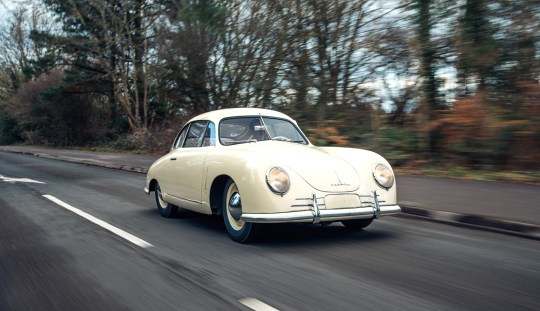




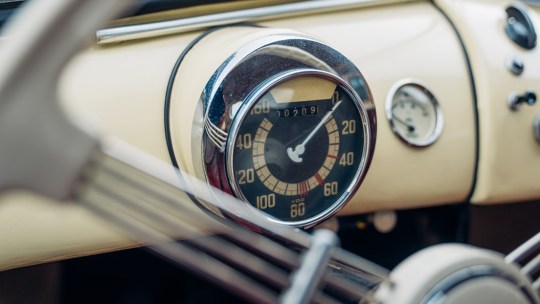


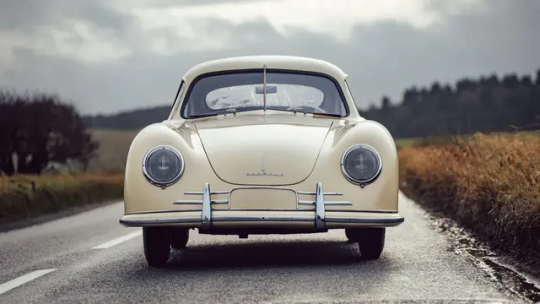
1950 Porsche “Gmünd” 356
It’s chassis number 356/2-0032 – the ‘2’ relates to the fact that it was in the first production run after the prototype ‘1’ car, a mid-engined, ally-bodied 356.
The Gmünd production run shifted the engine to the rear, like the VW Beetle on which it was so heavily based but kept the hand-beaten aluminium body panels.
This particular example was completed on 12th June 1950 and an early owner was Gert Kaiser, who gave it its first competition outing in the Rally to the Midnight Sun in Sweden. Naturally, in its 70-plus years of existence it’s been with various owners, including famous collectors in the US, before it came back to the UK in 2007.
Courtesy of DK Engineering
#art#design#sportcars#sportcar#vintage cars#vintage car#porsche#collector#1950#porsche gmund#porsche 356#LUXURY CARS#LUXURY CAR#luxury lifestyle#DK Engineering#gert kaiser#luxurycars#sport cars#luxurylifestyle#luxurycar
141 notes
·
View notes
Text
ARTICLE: The Florida Man of Formula 1 (2023)
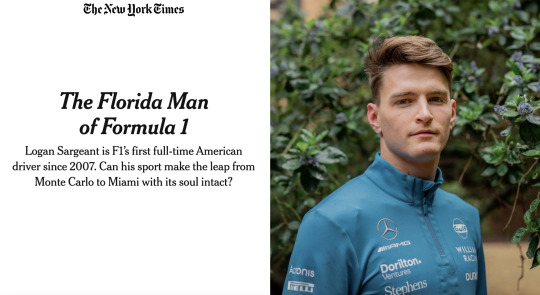
Source: Michael M. Grynbaum, The New York Times
Series: F1, 2023
Logan Sargeant, the only American driver in Formula 1, is zipping around the narrow streets of Baku, Azerbaijan, at roughly 200 miles an hour. His head bounces inside the cockpit as a wheel shudders over a rumble strip. It’s hard to hear over the banshee shriek of his V6 engine, carrying three times the horsepower of a run-of-the-mill Porsche Carrera.
Then the noise stops, and Baku vanishes. We’re inside a low-slung brick building nestled in the Oxfordshire countryside. The track, projected onto a CinemaScope-sized wraparound screen, was a mirage, part of a sophisticated training simulator. (F1 rules prohibit driving the real cars between races.) Mr. Sargeant climbs out of a replica driver’s seat wearing athletic pants. He won’t need a fireproof suit until later.
In three weeks’ time, Mr. Sargeant will do this for real: wind whipping his visor, G-forces of up to six times his body weight pressing on his neck, the ever-present threat of a catastrophic crash as he is watched by roughly 70 million people around the world. For now, it’s time for lunch. “Is chili bad for you?” he asks, digging into a bowl at his team’s commissary. “I don’t think it’s that bad.”

Williams Racing, in Grove, England. It was founded in Oxfordshire in the 1970s, but it’s now an American subsidiary: a Manhattan private equity firm, Dorilton Capital, bought the company in 2020 for an estimated $200 million.

F1 teams employ hundreds of employees and spend hundreds of millions of dollars developing the world’s most sophisticated racecars.
Reaching Formula 1, the highest level of international motor sport, is a big step for Mr. Sargeant, 22, a South Florida native who began racing rudimentary cars known as karts at 6 years old and this year joined the Williams Racing team as the first full-time American F1 driver since 2007.
For Formula 1 itself, finding a hometown hero for American fans is a giant leap.
Although it is enormously popular in Europe, F1 struggled for decades to break into the United States. That began to change in 2016, when the sport was purchased for $4.4 billion by the Colorado-based Liberty Media, owned by the cable magnate John Malone. Liberty ramped up its social media — F1 had barely kept a YouTube page — and backed a popular Netflix documentary series, “Drive to Survive.” Once geared toward aging white men, F1 now has a younger and more diverse fan base. American TV viewership is up 220 percent from 2018, and the sport made $2.6 billion in revenue last year.
Still, a subset of F1 devotees complain about what they see as an overemphasis on entertainment and ginned-up drama. Under Liberty, they argue, pure racing is taking a back seat to cheap tricks to reel in casual viewers. And they often use a dirty word for it: Americanization. “It is becoming more and more like Formula Hollywood,” Bernie Ecclestone, the 92-year-old Briton who built F1 into a global business, griped last year. “F1 is being made more and more for the American market.”
The backlash reached a crescendo at last week’s Miami Grand Prix, which was added in 2022 as a showpiece for American fans. In a prizefight-style pre-race ceremony, the rapper LL Cool J introduced the 20 drivers one by one amid swirling smoke and a squad of cheerleaders. Nearby, Will.i.am conducted a live orchestra playing the rap song he recently recorded with Lil Wayne as part of a “global music collaboration” with Formula 1. (The lyrics rhyme “Max Verstappen,” the name of the sport’s top driver, with “your champion.”)
“Pandering to the American audience is killing @F1,” wrote one fan on Twitter, echoing criticism that bubbled up across numerous F1 websites. Even the racers complained: “None of the drivers like it,” groused Lando Norris, a Briton who drives for McLaren. Undeterred, Liberty announced that the bombastic pre-race sequence would be featured at several more grands prix this year.
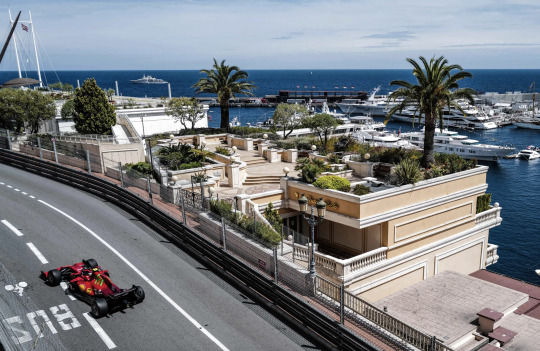
In the United States, F1 has long been associated with a certain European mystique, most famously, the louche glamour of the Monaco Grand Prix.
In the United States, F1 has long been associated with a certain European mystique. Its drivers race across the Ardennes forest (Circuit de Spa-Francorchamps in Belgium), the plains of Lombardy (Italy’s Autodromo Nazionale di Monza) and, most famously, the louche glamour of the Monaco Grand Prix. The sport’s stateside image could be summed up by the 2006 comedy, “Talladega Nights: The Ballad of Ricky Bobby,” which featured Sacha Baron Cohen as a pretentious French F1 driver named Jean Girard, a snooty Eurotrash foil to Will Ferrell’s macho NASCAR cowboy.
In 2023, F1 can feel a bit more Ricky Bobby than Jean Girard. In Miami, drivers circled a track built in the parking lot of the Dolphins football stadium, past an artificial Monaco-style “harbor”: blue-painted asphalt topped with ersatz yachts. A new Las Vegas race in November will have cars zooming down the Strip past Caesars Palace. Meanwhile, traditional races in France and Germany are gone.

Katy Fairman, a journalist based in Brighton, England, who runs the F1 podcast “Small Torque,” said she was surprised by the spectacle when she attended a race in Austin, Texas. “There were girls with pompoms,” she said. “I remember watching it and thinking, Oh my gosh, this is so different from anything I’d seen F1 do in a long time.”
Ms. Fairman conceded that some Europeans find the American hullabaloo “tacky.” But she added: “When it’s something to do with America, I think Europeans are quite judgmental. I think it’s just a bit of lighthearted fun. You guys like to have a party.”
The arrival of Mr. Sargeant, who grew up about an hour’s drive from the Miami racetrack, has spurred new interest, including a profile and photo shoot in GQ, and he’s happy to play the part. “What’s up America, let’s bring that energy!” he shouted to the cameras after LL Cool J introduced him as “the local boy done good.”
But as with F1, there are growing pains. In Miami, Mr. Sargeant finished last, his race ruined on the first lap when he damaged a front wing. After the checkered flag, he apologized to his team, his voice barely a whisper: “I’m so sorry. I can’t believe it.”
Weeks earlier, in an interview in England, Mr. Sargeant had demurred about the pressure of wearing the stars and stripes. “I try not to get too caught up in the talk of the role of ‘first American,’” he said. “It’s still very early for me, and I have a lot to learn still.”
If Mr. Sargeant doesn’t perform, there are dozens of drivers eager to take his spot. “At the moment,” he said, “I just have to worry about staying here.”

For a globe-trotting athlete, Mr. Sargeant can be soft-spoken and endearingly self-conscious.
‘I just want to get back in the gym.’
Before his tough Miami weekend, Mr. Sargeant was asked how he would celebrate a top 10 finish. “Honestly, it might sound lame, but probably just go back to my house and get in my bed for another night before I go back to London,” he replied. “That’s all I want to do.”
For a wealthy, handsome, globe-trotting athlete, Mr. Sargeant can be soft-spoken and endearingly self-conscious. It’s not unusual for someone who, like a tennis prodigy or Olympian gymnast, has devoted their life since childhood to a sole pursuit.
Mr. Sargeant was 6 when he and his brother Dalton got a kart from their parents for Christmas. “No one in the family was really even that much into racing,” Logan said. “We just picked it up as a hobby, something to do on the weekend.” He began winning junior races around the country — too easily. To reach the next level and pursue Formula 1, he’d have to leave behind his friends and beloved fishing excursions for life on a different continent: “We just needed a higher level of competition, and at the end of the day, that was in Europe.”
Mr. Sargeant left Florida before his 13th birthday, bouncing between Italy, Switzerland and Britain as he raced on the European junior circuit; in 2015, he became the first American to win the Karting World Championship since 1978. “As a kid, it was tough,” he recalled. “Coming from Florida, being outdoors all the time on the water, great weather — it was literally vice versa.” He eventually settled in London, where he spends most days working out with a trainer. “I get away from a race weekend, and I just want to get back in the gym,” he said. “I hate that feeling of leaving slack on the table.”
It is incredibly difficult to nab a seat in Formula 1. Today’s drivers are physical dynamos trained to optimize their reflexes and performance levels down to how well they can withstand jet lag — critical in a sport that this year will include 23 grands prix spread over five continents. F1 teams employ hundreds of employees and spend hundreds of millions of dollars developing the world’s most sophisticated racecars. But it’s ultimately up to the driver to execute.
It also helps to have money. Lewis Hamilton, the seven-time world champion and F1’s only Black driver, is an exception, having grown up on a London council estate. Many F1 competitors are the sons of multimillionaires (and some billionaires) who can bankroll pricey travel and high-tech cars.
Mr. Sargeant falls into the scion category. He hails from a wealthy Florida asphalt shipping family. His uncle, Harry Sargeant III, is a former fighter pilot and onetime finance chair of Florida’s Republican Party who has been sued by the brother-in-law of King Abdullah II of Jordan and whose name turned up, tangentially, in the 2020 impeachment of former President Donald J. Trump. (Harry was not accused of any wrongdoing.)
Logan’s father, Daniel Sargeant, worked alongside Harry until the brothers had a falling out. In a 2013 lawsuit, Harry accused Daniel of misdirecting $6.5 million in corporate funds “for the purpose of advancing the international cart racing activities” of his sons, Logan and Dalton; that litigation was eventually settled.
In 2019, Daniel Sargeant pleaded guilty in federal court in New York to foreign bribery and money laundering charges related to his business dealings abroad. He is free on a $5 million bond and is awaiting sentencing. A Williams spokesman said that Logan Sargeant was not “in a position to comment” on any of the legal matters involving his family.
In F1, none of this particularly stands out. The mother of Mr. Sargeant’s Williams teammate, Alexander Albon, was jailed in Britain for swindling millions of pounds in fraudulent sales of high-end cars. A Russian racer, Nikita Mazepin, was booted from the sport after his oligarch father, a close ally of President Vladimir V. Putin, was sanctioned following the 2022 invasion of Ukraine.
James Vowles, the Williams team principal, said in an interview that he hired Mr. Sargeant for his speed, not his U.S. passport. “I’m incredibly pleased that the sport is growing in America, but I think it would be anything but disingenuous to say that Logan’s here for any other reason than I think he’s got this pure talent,” he said.
In his F1 debut in Bahrain in March, Mr. Sargeant finished 12th, outpacing this year’s two other rookies. “He has this insatiable desire to be better, to want more,” Mr. Vowles said. “He’s a perfectionist, and I like that in him.”
Tooting around in a Vauxhall Astra
Britain, where Formula 1 originated in 1950, remains the sport’s spiritual home, where most of its 10 teams are based. Williams was founded in Oxfordshire in the 1970s, but it’s now an American subsidiary: a Manhattan private equity firm, Dorilton Capital, bought the company in 2020 for an estimated $200 million.
It was an important cash infusion for a team that had struggled to keep up with rivals. Manufacturers like Mercedes-Benz pour enormous resources into their F1 teams, which double as an elaborate global marketing campaign and an in-house innovation farm; tech developed for F1, like engines that recycle braking energy as an accelerant, can trickle into consumer vehicles.

Formula 1 car simulators at the Williams Racing factory.

Formula 1 drivers practice on sophisticated training simulators.
The Williams campus is a humdrum brick pile that could be mistaken for an office park — a far cry from McLaren’s space-age complex an hour’s drive away. Many F1 teams provide their drivers with a high-end sports car for personal use; Mr. Sargeant commutes in a Vauxhall Astra, a compact.
Even the team’s sponsors are relatively down-market; whereas the official watch of Ferrari is Richard Mille (starting price: $60,000), Williams has a deal with Bremont, whose timepieces retail for significantly less. (On a recent visit, a Williams press aide was quick to extract a spare Bremont watch from his pocket and ensure Mr. Sargeant was wearing it whenever a photographer hovered.)
Given the huge costs, corporate partnerships are crucial to F1, part of the reason the American market, with its abundance of affluent consumers and wealthy brands, has proved so tempting. Gerald Donaldson, a journalist who has covered F1 for 45 years, recalled how cars were gradually taken over by corporate logos starting in the late 1960s.
“Marlboro paid all the Ferrari bills, including the drivers, for many years,” he said in an interview. “There are eager companies who want the publicity.” Mr. Sargeant’s car features ads for Michelob Ultra beer and an American financial firm, Stephens. In Miami last weekend, beachgoers spotted an airborne banner reading “Go Logan!” alongside the image of a Duracell battery.
Last year, the Miami race was viewed on ABC by 2.6 million people, the biggest American audience for a live F1 telecast. Ratings for this year’s race fell about 25 percent, perhaps a result of a duller-than-usual season dominated by one team, Red Bull.
Still, viewing data show that F1 is expanding beyond affluent cities associated with elite sports: In 2022, its top five American TV markets included Asheville, N.C., and Tulsa, Okla. ESPN is clearly betting on more growth. When the sports network renewed its broadcast rights last year, it agreed to pay $90 million annually — up from the $5 million-a-year deal it signed in 2019.
Liam Parker, a former adviser to Boris Johnson who now leads communications at F1, said the sport was intent on rectifying past mistakes. “We were too arrogant,” he said. “We couldn’t understand why the American fan base wasn’t falling in love with us.” But he also pushed back on the complaints that Liberty’s efforts to raise the entertainment factor had stripped F1 of something essential.
“This whole argument of ‘Americanization,’ it’s a very crude way to describe things,” he said. “We shouldn’t ignore things that can improve things for new and core fans. It’s about giving people more choices in the modern era. It’s modernization of access to everyone.”
Mr. Hamilton, arguably the biggest celebrity of the current F1 lineup, has offered his own endorsement of Liberty’s approach. “I mean jeez, I grew up listening to LL Cool J,” he told reporters in Miami. “I thought it was cool, wasn’t an issue to me.”
For all the debates over elitism, good taste and corporate rap collaborations, the core appeal of F1, when you get right down to it, may be something simpler — something Mr. Sargeant got at when asked in the interview if he had loved cars as a kid.
“I absolutely love driving, as you can imagine,” he said. “But to be honest, I’m not one of those people who studies cars and, you know, likes to know every detail of every single car. It doesn’t really interest me.”
“The part that interests me,” he concluded, “is driving them as fast as I can go.”
Eliza Shapiro contributed reporting from Miami. Kitty Bennett contributed research.
Michael M. Grynbaum is a media correspondent covering the intersection of business, culture and politics.
A version of this article appears in print on May 14, 2023, Section BU, Page 1 of the New York edition with the headline: The Florida Man Of Formula 1.
#logan sargeant#year:2023#source:newspaper#one of the best logan articles imo#feel free to message me if you want me to gift you a copy of this article from the NYT with my subscription
72 notes
·
View notes
Photo

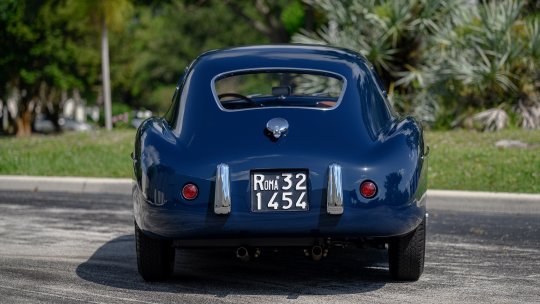

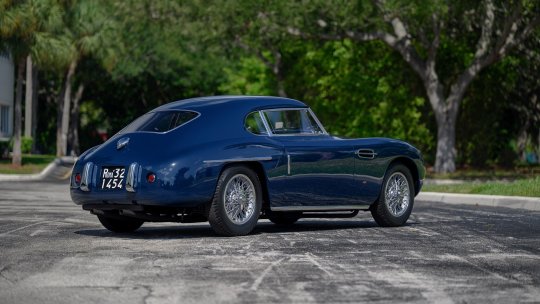


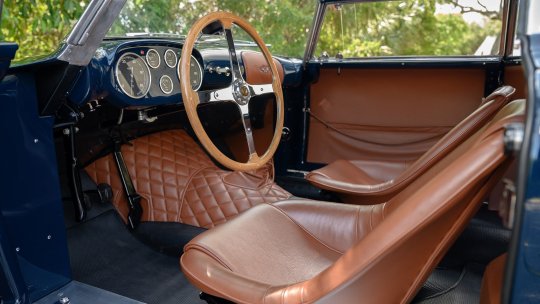
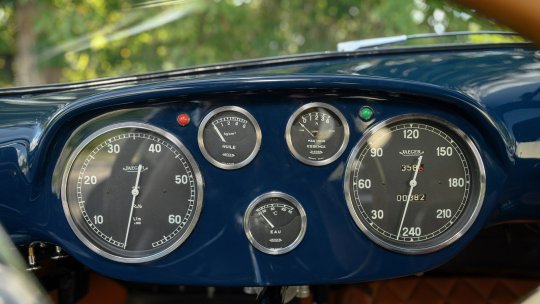
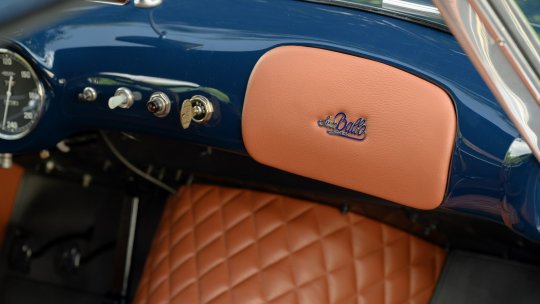
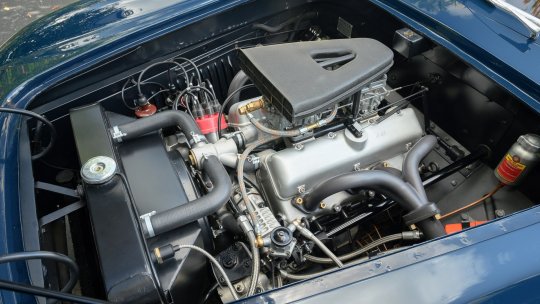
Siata 208 CS ( 1 of 6).
Societá Italiana Auto Trasformazioni Accessori (SIATA) created a marvelous assortment of machinery in its 45-year history under the guidance of the Ambrosini family. Founded by Giorgio Ambrosini in 1926, Siata specialized in performance modifications for Fiats, creating the overhead-valve conversions, multi-speed gearboxes, superchargers, and multi-carb intakes that competitive Italians wanted for their diminutive cars. The Italian auto giant conspicuously ignored—with few exceptions—the high-performance market as the Agnellis concentrated their empire around sensible, reliable, and mass-produced cars of small proportions.Siata received substantial financial assistance from Fiat following the Second World War, and by 1949 they were producing small automobiles which wore custom, house-labeled coachwork. Firmly grafted to Fiat and its engineering, Siata took a giant leap forward with the arrival of Rudolf Hruska in 1950. Hruska had worked in Porsche’s design office before the war and later collaborated with Carlo Abarth on Piero Dusio’s Cisitalia Grand Prix project. Fiat itself plotted its re-entry to the top ranks of Italian performance automobiles in 1950 with the introduction of their two-liter V-8 (dubbed "Otto Vu"), whose development was entrusted to Siata and executed in total secrecy by Hruska’s team.
The unusual oversquare, 70-degree V-8 engine featured all-aluminum castings with wedge-shaped combustion chambers. Induction was through a pair of dual-throat, downdraft Weber carburetors. With its high-revving short-stroke design and 8.5:1 compression ratio, prodigious power was channeled through a four-speed manual gearbox. Hruska planted the engine into a tubular chassis, and this became the basis of Fiat’s 8V.
Debuting at the 1952 Geneva Salon, the 8V caused an absolute sensation perhaps best equated to a meltdown of Italy’s motoring press. For many, the Siata-developed, Fiat-badged supercar defied belief. In particular, the advanced chassis featured a fully independent suspension with coil springs and telescopic shock absorbers at all four corners and was a marvelously sophisticated platform for its time, with supple and predictable handling that amazed drivers accustomed to the rigidly sprung, “flex-framed,” live-axle sports cars of the time.
Approximately 200 Tipo 104 engines were made to supply the 114 8V examples which Fiat ultimately produced. Eighty-five or so surplus engines were thusly returned to Siata, which seized the opportunity to supply them with additional house-made upgrades and implant them into the very chassis from which the earth-shattering Otto Vu had been developed.
The resulting Siata 208 CS was available as an attractive barchetta-like Spider or streamlined berlinetta, which Siata commissioned from a small pool of local coachbuilders including Bertone, Vignale, and Stabilimenti Farina. It is said that Siata openly encouraged the carryover of major styling details which these same companies were providing to Ferrari during the same period.
Perhaps the shapeliest design ever rendered upon the 208 CS, however, was executed by Balbo of Turin. Just nine berlinettas were made, of which only six examples are known to remain extant.
248 notes
·
View notes
Text
So, there's many of you now.
I know we're in the How Sweet It Is Not To Know Follower Counts website and I do cherish that, but still, more people than ever in my life clicked a button that in some capacity says "I care what this dork has to tell me" and I want to acknowledge and celebrate that - especially now that this growth seems to have settled into its rhythm.

Spot when @identifying-cars-in-posts reblogged my pinned, lol.
So, for my 100th post, I felt like celebrating our love for reaching round numbers. And little in the automotive world represents it more iconically than what reigned supreme above all cars in the 1980s.
Porsche started out as an engineering firm, whose most notable contract was what would become known as the Volkswagen Beetle (and boy what a story that is). The first car of its own was the 356 seen below - a sporty body laid over Beetle underpinnings and thus still mostly made by Volkswagen. But by God, they were going to run with that recipe and perfect it 'til the sun burst.
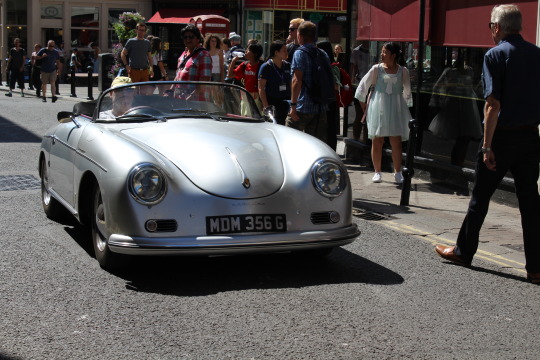
Meanwhile, in England, a chap called Colin Chapman decides the next of his company's track cars will actually be drivable on the street, to need no trailer to go race. Thus the Lotus Seven is born and sold in kit, which avoids high taxes on the exporting of cars to the US (but those taxes would have remained had they been sold with assembly manuals… so they were sold with disassembly manuals for you to read backwards. No, seriously.).
The Porsche 356 kept getting less and less Volkswagen and more and more Porsche until in 1964, the year of the Beatles, the year of the Stones, the stone-age Beetle was left behind for good with the Porsche 911 (seen below), a blank-canvas take on the same recipe of an air-cooled rear boxer engine powering the rear wheels of a squished-Beetle-shaped sportscar. 'Twas good.
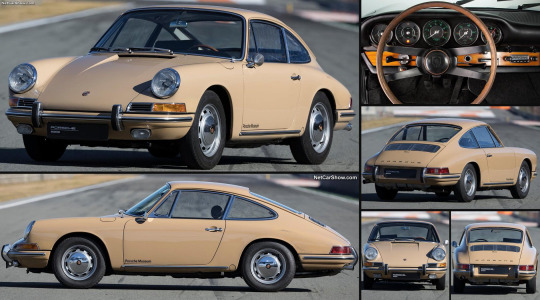
In 1973, Lotus was doing pretty well for itself. The Seven's whole 2500 sales had carried it through producing a number of other models, and a few were even in production concurrently - a lineup! Exciting stuff!
Well, that and an F1 team so successful its Wikipedia page features the section "Domination in the 60s and '70s".
The exciting opportunity to move upmarket, with bigger models with AC and automatics and all that bougie shit, pushed them to move away from the image of scruffy old kit car makers, ceding the Seven's production to the last two dealers that sold it, main one being Caterham Cars.
The 911 headed into the 80s old enough to drive, and Porsche's plans considered it at the end of the line, with staff already mourning it.
But then the yankee at his third week as CEO saw those plans (which to Germans are basically scripture), said "to hell with that" and extended that line off the chart.
Literally. He went to the lead engineer's office and physically took a marker at a development chart. They all secretly liked that.

Still, it was clear the game was changing - intercoolers, all wheel drive, active suspension... how hard could the 911 layout go if it didn't stick to its simple air-cooled roots?
Well, Porsche resolved to find out by filling it with the cusp of automotive advancements and then some. And I do mean filling - a chassis that didn't even need space for a radiator was suddenly tasked with storing it, two turbos, two intercoolers, and a good half dozen oil pumps.

Yeah good luck with that, buddy.
Oh, and materials? The body was kevlar, the frame was aluminium, the floor was Nomex (ever even heard of Nomex???), the wheels were magnesium and the spokes were hollow!!!! You could blow into the spokes!!!
And don't get me started on the technology! Variable height, an all-wheel-drive system that distributed torque at will, electronics galore...
As you may be able to guess, development was… complex.

At one point a test driver was doing 180km/h (112mph) to go get the car un-on-fire-d, and that's just one of the plenty horror stories.
Hell, work started in 1983 to create a car for Group B and took so long that when said rally series died in 1986, production was just starting. Not that development would stop at the start of production, either - the first cars just got updated when the owners took them in for their service. (Can't blame them, I fix wording in weeks-old posts...)
But however long it took, the resulting Porsche 959 answered the originating question "How hard can this chassis go?" with a resounding "Hard and then some".

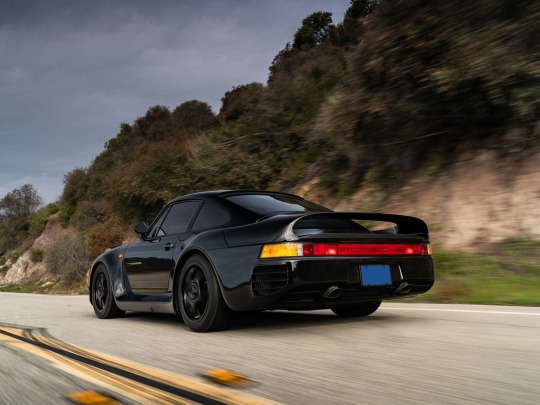
It was comfortable and refined enough to be driven every day, but so capable it extended the limits of the concept of production car. Put it this way: it reached car people's favorite round number, 100km/h (to yankee doodles, 60mph) in 3.6 seconds. The second fastest production car did so in 4.6. That's one second of margin in a race that ends in five. Oh, and if you want to put it another way: the 959 was the first production car to ever surpass 300km/h, let alone come 1 shy of the mythical 200mph (322km/h).
Meanwhile, the handful of chaps at Caterham was still producing the Caterham Seven. It's the Lotus Seven (specifically the third revision, from 1968), but I guess in '83 the engine changed.
We were saying?
They couldn't sell the 959 stateside for lack of crash test data, and America's ban on importing foreign cars under 25 years of age had no exception. That is, until Bill Gates wanted a 959 so bad he spent 13 years getting an exception passed. That's how hot this car is.
And yet, this record-breaking, boundary-pushing, master-of-all-trades hypercar sits atop the 80s automotive landscape engulfed in shadow. But how? Why?
Because it failed to contend with the greatest automotive headache: humans.
It was planted, practical, reliable, predictable - docile, domesticated, amicable. Perfect. But these are not meant to be cars, they're meant to be posters. And you don't get posters of what is perfect, but of what excites you. And what excites us is the visceral, the raw, the uncompromising - the wild, the feral, the dangerous. And, of course, reaching round numbers. What excites us is a lot more like the first production car to break 200mph, the Ferrari F40.
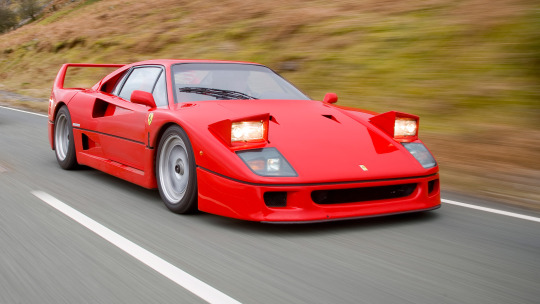

Remember how the 959 was being developed for Group B racing and then the series died? Well, Ferrari got screwed over too, with the 288 GTO Evoluzione they were developing (seen here to the right of the base 288 GTO) suddenly having no reason to be.


The lead engineer then asked Enzo Ferrari to let him turn that weekend project (literally, they couldn't spend work week time on it) into a road car to celebrate their 40 years. Enzo, nearing the end of his days, thought "Ah, what the hell, let's leave with a bang", so they set off to build what would become the anti-959.
Not anti as in response, but as in antithesis.
Where the 959 was an attempt to modernize the noisy, unrefined, old-school 911 -to make a supercar "tested for everyday usability to the most strenuous standards", by Porsche's words- the F40 was a reaction to, per Ferrari's words, "customers saying Ferraris were becoming too plush and comfortable": "nothing but sheer performance. Not a laboratory for the future, as the 959 is. Not Star Wars."
To exemplify: left is the 959 - note the leather and electric seats, right is the F40, note the string you open the door with.
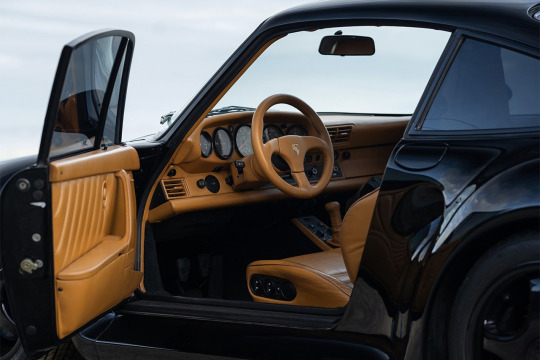

The F40 was noisy, crashy, torrid, and the turbo lag painstakingly smoothed out in the 959 here kicked you in the back like a locked door. It would rip your head off the moment it sensed you didn't know what you were doing. But it was more exciting - to look at, to hear, to drive. And that's what won people over - including the buyers, which were near four times as many as Porsche's despite the price tag being double.
Had the 959 lost then? Well, not quite. Enter the 959 S.
Doing away with much of the 959's luxuries, like adjustable suspension, electric windows, AC, central locking, and even backsea- wait, the 959 had BACKSEATS???? Holy FUCK why does no one talk about that??? Take the family on a trip to 300kphville! I was saying. They schlapped some bigger turbos on too and power went from 444hp right past the F40's 470hp to a healthy 508, that propelled it over what any roadgoing F40 ever managed at 211mph, or 339km/h. Presumably for bragging rights.
And I want to stress, these were titans clashing here. This was leagues beyond what other production cars could even comprehend. Again, the 959 hit 100km/h in 3.6 seconds. The F40 held a record by taking less than 16 seconds to go from 0 to 160km/h(100mph) and back to 0. This was witnessing superhumans fighting through the clouds.
And then in 1992, the two chaps that 'developed' Caterhams (i.e. banged new ones together in the shed) told the chap they worked for "Hey, let's make one that's really barebones and fast", rang up their ol' mate (and ex-F1 racer) Jonathan Palmer to ask to lend a hand, and bought some of the 250hp engine that powered the Vauxhall (British for Opel) Cavalier GSi in the British Touring Car Championship.

Thus, the Caterham Seven Jonathan Palmer Evolution - a raw, uncomfortable, uncompromising beast that went fast as all fuck.
Now, if you don't know Sevens you may think "Ah, so just like the F40, what with its handcrank windows and the string to open the doorlatch and all". And to illustrate how far off that is: in the Seven the windows were sown on and you latched the door yourself with a button.

And that's the standard version which had windows and doors. The JPE didn't.

The JPE had a carbon tub you were meant to call a seat, the controls, a rev counter and a tach that didn't even bother with speed under 30mph, and fuck you.
And this one is not even as barebones as it gets: this one is painted.
So while the F40 went from 1,250kg (2760lb) to 1370kg (3020lb) when adjusted to comply with US regulations and the 959 went from 1450kg (3200lb) to the lightweight S version's 1350kg (2975lb),
the Seven JPE weighed 1170. As in 1170lb. 530kg. Read that again if you need to, but it had about half the power of those two and considerably less than half the car to move.
And so, in January 1993, this thing -this '50s coffin with a Vauxhall engine banged together by one guy in a shed- took the Guinness World Record for fastest car to 100km/h with a time of 3.46 seconds - and the 0-160km/h-0 record with 13.1 seconds. Close your eyes and picture that.
Yet the Seven JPE is hardly known to anyone but the most hardcore of enthusiasts, and owned by barely four dozens of 'em. So did it, perhaps, ultimately lose?
Not at all. In fact, none of these cars did.
Every 959 cost Porsche twice what they sold it for, but the project proved the 911's layout could stand the test of time, and its development gave Porsche technologies it gradually infused into the 911 keeping it relevant, competitive, and most importantly alive to this day.

And I think we can safely say that when Enzo Ferrari died in 1988, a year after the F40's launch, his wish to leave with a bang was perfectly fulfilled - so much so that the F40 is commonly regarded as the peak of his legacy.
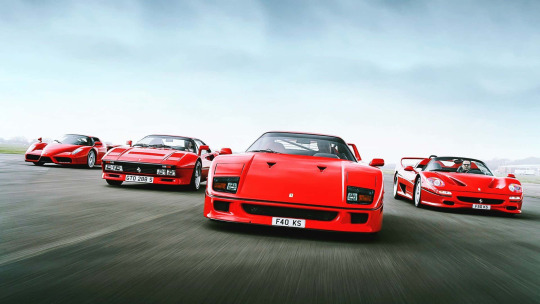
And the JPE was simply the greatest Seven ever - the most raw, thrilling, pure automotive experience the streets had ever witnessed. If driving a fast car was like biking down a hill, the Seven JPE was skydiving.
Hell, it was the cover car of éX-Driver, an anime about a team using old-school sportscars to rescue haywire autonomous vehicles!


Not that culturally relevant but MAN was it cool as a kid. I need to hang those damn posters one of these days. I was saying.
These are three success stories in three radically different ways.
Because, as much as I've made this post all about the numbers, sometimes it's not about that.
Sometimes it's about making a show, leaving a mark, being spectacular.
Sometimes it's about pushing yourself to achievements you can take pride and inspiration from.
Sometimes it's simply about having fun seeing just how far you can really go.
Sometimes it's about deciding what you want to be and make a new favorite version of yourself, that is the best it can be at what you care the most about.
And for some that may result in less popularity or success or impact or legacy than others, but those are just some of the things you can work towards.
It can be okay to just work towards having a blast.
Hell, those madmen at Caterham used to stay after work to build themselves track cars, race them the next day and put ‘em back in the workshop after racing them, and the company survived to this day.
Because, yes, they're still around - and their new lineup topper gets to 100 in 2.8. Windshield still optional.
Well, at least there's headrests now.
And a wider version, for the concrete possibility that you physically don't fit.

Never change, Caterham, because you certainly never have.
Links in blue are posts of mine explaining the words in question - if you liked this post, you might like those!
#this was meant to also celebrate 300 followers#i am just that slow at writing stuff#porsche 356#porsche 911#porsche 959 s#ferrari 288 evoluzione#ferrari f40#lotus seven#caterham seven jpe#vauxhall cavalier gsi#round numbers
44 notes
·
View notes
Text

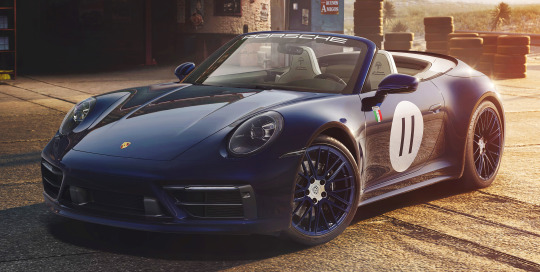
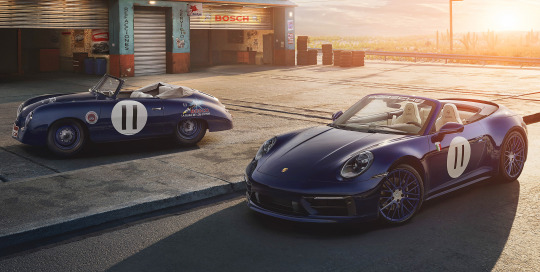
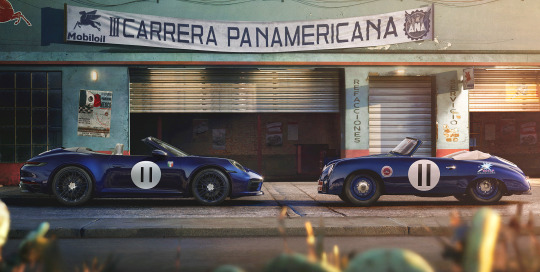


What a difference 70 years makes juxtaposition of Porsche 356 S Cabriolet, 1952 & Porsche 911 Carrera S Cabriolet, 2022. To commemorate the company’s successful entry into the Carrera Panamericana Porsche Latin America and Porsche Mexico have created a special one-off that matches the appearance of the race car from the 1950s. It has been finished in Gentian blue with wheels also in blue with grey centres like the original. The brake callipers are painted black and roundels bearing the number 11 added to the sides of the car. The car has been presented ahead of the 35th running of the “modern” Carrera Panamericana. The one-off 911 will be auctioned with the proceeds going to charity
#Porsche#Porsche 356 S Cabriolet#Porsche 911 Carrera S Cabriolet#one-off#tribute car#70th anniversary#replica#Carrera Panamericana#road race#charity auction#What a difference#1952#2022#one of one
204 notes
·
View notes
Note
https://www.tumblr.com/mistressemmedi/740063884004802560/anyways-the-funny-thing-about-the-dakar-is-that?source=share
Can you explain the full story, please?
Absolutely but we need to start from the beginning. Back in the 70s this French madlad, Thierry Sabine, got lost in the Sahara while competing in another rally raid. He made it back to civilization and thought to himself "This was a great experience, we should make it a regular thing! Rally raids in the desert!" so, in 1977, Thierry organized a large scale rally that would cross the whole Sahara - starting point would be Paris and the end would be the capital of Senegal, Dakar.
I guess Thierry was not the only madlad around because 180+ other drivers/riders etc decided to join in on the fun. Popularity rose the following few years thanks to big name entries such as Jacky Ickx. The rally was very much an adventure: you got a general map indicating stops you should make on your way to Senegal and... That was kind of it. No teams, no real backup. People showed up in modified everyday cars, someone even raced in a modified Rolls Royce lmao
So by 1982. the rally was kinda known but it wasn't the scale it was today. Enter our main character: Mark Thatcher, absolute weapon of a man (honestly, look him up... Man does not sound like he's the sharpest tool in the shed lmao) and unfortunate son of one Margaret Thatcher (prime minister of England at the time). He decides to enter the rally with his lil Peugeot 504 with no real prior experience besides racing Le Mans twice (which... uh, very different from a rally in the desert). So he starts off with his co-driver and mechanic in tow and gets lost in the desert. It happens, right? People usually turn up after a day or so. Well, after 3 days he's officially declared missing and mommy dearest is informed. Obviously the son of the Prime Minister being lost somewhere in the Sahara is quite a big deal, so the news was all over that, and Old Maggie decided to flex some of that British muscle - a rescue is launched, involving three separate countries who sent out military aircrafts to search for this moron in the desert, as well as Algeria dispatching its soldiers to find the guy.
After a few days, Mark is found about only 50 kms away from the main route of the race 💀 which caused quite a bit of embarrassment on an international scale to his mom.
Anyways, bad publicity is still publicity after all, and by the year after there were 450+ entries to the rally which included big name manufacturers such as Porsche etc. and it evolved in the crazy 2 week rally that we know today!
Bonus - Quotes from Mark Thatcher about the whole ordeal:
Before competing he said:
"I've now raced in Le Mans and other things – this rally is no problem."
In 2004, Thatcher wrote about his experience:
"I did absolutely no preparation. Nothing."
"We must have hit something. ... We stopped. The others stopped too, took a note of where we were and went on. But the silly bastards – instead of telling everyone we were 25 miles east when they finished the section, they told them we were 25 miles west."
"So The Boss (the prime minister) does entirely the right thing, picks up the phone to the ambassador in Algiers and says, "Can you find out what is going on?" The ambassador then rings the prefect of the region who says there are four people missing and that I am one of them."
18 notes
·
View notes
Text

When asked how we got together, we always answer: ‘Liz Taylor and James Dean.’ But we really owe it all to Richard Miller, the freelance entertainment and stills photographer, who captured the image of them relaxing on a sofa in Houston, Texas in 1955.
In truth, saying ‘Richard C. Miller’ doesn’t carry the weight and humour of saying ‘Taylor and Dean’, but it should. We have all heard the adage, ‘a picture is worth a thousand words’, and we don’t disagree – but what of the person who took it, or the people in it, what we take from it, or what happens because of it? We feel that those stories are equally as captivating, should be shared, and well… at times, they may take a thousand words to tell.
So, we thank Hollywood Authentic and our dear friend, Greg Williams, for indulging us with this opportunity in the forthcoming issues to share the stories of how some of the most iconic images were taken, pay homage to the extraordinary photographers behind them, and take you on the journey of how the love of photography changed our lives forever.
Over the course of his career, Miller took photographs of celebrities and stills on more than 70 movie sets, with his work appearing in The Saturday Evening Post, American Weekly, Colliers, Time and LIFE. He was one of the first photographers who took pictures of Norma Jean for the Blue Book Modeling Agency long before her transformation into Marilyn Monroe, and he covered the set photographs of what would be Dean’s third and final film, Giant. Which brings us to this photograph.
Miller studied to be a cinematographer and was an actor prior to establishing himself as a photographer. Dean aspired to be a film director and shared a passion for photography – among his closest friends were notable photographers Phil Stern, Dennis Stock and Roy Schatt (the latter being Dean’s photography instructor who had also given Dean his Rolleiflex). Hence why when Miller met Dean, they became fast friends who bonded over their love of Porsches, cameras and the filmmaking process, and Miller told his wife, ‘This is a guy who will be a best friend for life.’
A great image is typically generated by knowing when to click the shutter, but it also needs the right elements of composition. Between the photographer and the subject, cooperation and collaboration, magic can happen. Miller recounted that when Dean saw him about to take the photograph, he would do something to make it better; a look, a stance, a gesture, and in this case, simply grabbing the LOOK magazine featuring Taylor on the cover as Mother of the Year, while she napped beside him.
This very photograph is what brought Gary into the gallery where I worked and now hangs proudly in our home. It’s the image that we bonded over, and began our conversations on cameras, film and photography; it is what started us on the path to becoming best friends and partners for life. And come to think of it, Gary did drive over in his Porsche.
3 notes
·
View notes
Text
Porsche 918 Spyder
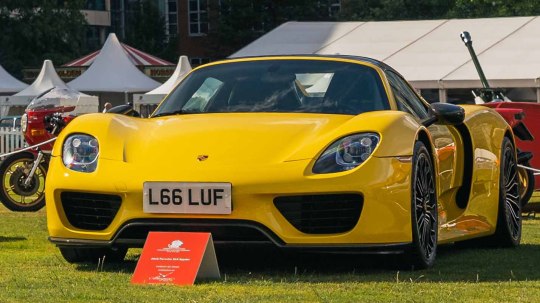
#Porsche 918 Spyder#918 Spyder#Spyder#Porsche#Porsche 918#porsche spyder#supercar#supercars#fast#fast car#fast cars#super cars#hypercar
21 notes
·
View notes
Text

They should have been Chappaqua's most eligible bachelors in the late 1960s and early 70s.
The Bass twins (Sea and Rankin) had money, property, devilish good looks, the whole nine. Sea knew his way around the curves at Le Mans (first American to represent Jaguar, Porsche, and Ferrari in consecutive years), and Rankin flew experimental aircraft on weekends when he wasn't sailing.
But they shared a common and, ultimately, unobtainable goal:
The fellas planned one day to marry twins.
To that end, a search was conducted through the years, going back to the seventh grade, actually. And it will surprise no one to learn that the idea was solely the contrivance, scheme, and unhealthy obsession of their older sister, Elle.
This weird, and, at times, sordid plan was among many machinations "for the family" that Elle was behind, about which two Bass stepmothers might have something to say if they were not so very, very deceased. (Elle had a third potential Mrs. Bass lined up for their dad, Bass Bass, but that's not pertinent to the holiday moment pictured here.)
Instead, in this scene we see yet another presentation of the engagement "pitch" to the Belvedere twins, Ring and Sunset.
Rankin had instantly seen the bonus of how, should nuptials proceed apace, initials on the two couples' luggage and sweaters would be a real hoot.
In that box being offered to Sunset is a cashmere example thereof, compliments of a custom purchase Elle had made in London.
Sea has champagne at the ready.
Courtship? What's that? I mean, you should see those clusters of mistletoe hanging above a massive sconce in the foyer.
3 notes
·
View notes
Text
Who killed Tobirama Senju?
"We start with breaking news. Konoha Police Department is asking for help in locating 25 year old Tobirama Senju. He was last seen on last night, on May 14th, near the parking lot of Konoha University, driving away in a black Porsche that was found this morning abandoned near the Suna-Konoha highway. Tobirama Senju is 1.83 meter tall, weighs 70 kilograms, with red eyes and white hair. Was last seen wearing a blue t-shirt and a black pants with black converse. If you have any information regarding Tobirama Senju, please contact Konoha Police Department..,"
7 notes
·
View notes
Text
2022: a summary
post your favorite or most popular post from each month this year. (it’s okay to skip months!)
i was tagged by @brooksdavis and @william-byers thank you so much 🥰 this was so much fun to look back through sets and see progress in colouring!!!
january
fave: ryan calling shane daddy
top: bears, beets, battlestar galactica
february
fave: parks and rec surprise face
top: derry girls “we’re pack animals”
march
fave: the office jim asking pam on a date
top: pride and prejudice
april
fave: heartstopper + ryan & shane at knott’s berry farm
top: well damn jackie i can’t control the weather
may
fave: rent + pride and prejudice
top: nick nelson with nellie
june
fave: ghost files you son of a bitch + the office dwight’s wigs
top: ms marvel
july
fave: stranger things
top: ghost files trailer
august
fave: ted lasso diamond dogs
top: that 70s show
september
fave: kinn/porsche in the waterfall + ghost files episode one
top: derry girls swear on dolly
october
fave: ghost files nerd + heartstopper hug
top: derry girls not properly english
november
fave: puppet history/avengers + roy/keeley
top: derry girls well it makes it not incest
december
fave: derry girls + the office
top: parks and rec threw up in the shower
tagging: (no pressure though and sorry if you’ve already done it!!) @enidsniclair, @klinejack, @tylrgalpins, @carloslouwho, @nessa007, @robiinbuckley, @niccolofares, @usergrantaire, @jakeyp, @mikhaailo
10 notes
·
View notes
Text

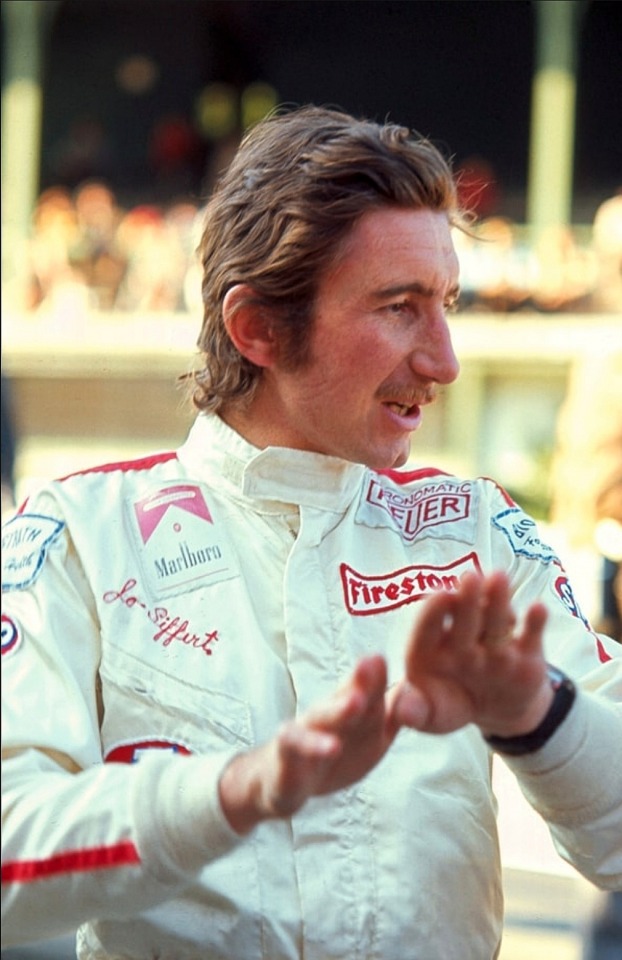
Happy birthday JO SIFFERT!!!!!!!!!!!!!!!!!!!! (07/07/1936 - ∞) 💙⚡
Joseph 'Jo' Siffert, nicknamed by his family and friends 'Seppi', was born in Fribourg, Switzerland, to a poor family, his father was a dairy owner and it's thanks to him if Jo got interested in motorsport: at the age of twelve, he took him to Bern, to see the 1948 Swiss Grand Prix; from that day Jo knew that he wanted to become a racing driver. After concluding his mandatory school years, in 1951, he started working as an apprentice in a workshop that mainly repaired cars; there he would meet the swiss driver Benoît Musy, with whom he developed a great friendship (after Benoît's passing, Jo would make a tribute to him with his helmet design).
Like many other racing drivers (von Trips, Surtees, Ickx), the young Seppi, made his motoracing debut in the world of motorbikes in 1957, and quickly made his name known by showing his determination and talent, that later would earn him the Swiss 350 cc motorcycle championship in 1959, before switching to the the world of four-wheel racing by joining the Formula Junior.
After two years, Jo finally made his debut in Formula 1: he took part at the '62 Monaco GP, racing in a Lotus-Climax for a private team, the first of many others, because during his racing, Jo changed a few teams, like in 1964 he joined the Rob Walker racing team, with whom he earned three important victories: he won the '64 and '65 Mediterranean GPs, both were non-championship, but this gp was considered to be very prestigious, and later he would win the '68 British GP, which was the first official victory for the Swiss driver with the private team, that later he would leave in 1970 to join March. His second victory would later come once he joined the BRM team in 1971, at the Austrian GP; but unfortunately that would be his last, that same year Seppi would pass away in a tragic accident during a non-championship race held at Brands Hatch.
Jo always demonstrated to be a very versatile driver: after becoming the lead driver for Porsche, he participated often at the 24 hours of Le Mans, he won the 24 Hours of Daytona and the 12 Hours of Sebring along with Hans Herrmann, and other tricky competitions like the 1000km of Spa and the '70 Targa Florio. Porsche would later choose Seppi to start their new racing programme in the Can-Am series in 1969.
Jo was also known for being the testimonial for the Heuer watches, and used to sell them to his fellow F1 drivers like Graham Hill, Jim Clark, Jochen Rindt and many others. Being the testimonial, in '69 it was released his own personilised version and was called the 'Heuer Autvia': it had an elegant white watch face with light blue details. The watch had a big success, but despite that, after Jo's passing, Jack Heuer, preferred to remove it from trade and never use those colours again.
#happy bday seppi!!!!!! 💙✨#jo siffert#classic f1#f1#formula 1#retro f1#f1 1960s#f1 1970s#24 hours of le mans#motorsport#f1_bdays
28 notes
·
View notes
Note
MileApo (70) is higher on the ship list of tumblr's year in review than kinnporsche (81)
Nonnie!!!! how are you? <333
I saw liyazaki's post on this!
it was written 'kinn x porsche' in the post where the ranks are mentioned so i'm going by the exact wording of the tag
You know what nonnie....i feel a lot of 'kinn x porsche' ship tag got engulfed in the 'kinnporsche' tag itself...like i, for example, have tagged my original kinn and porsche content as 'kinnporsche' for the series and the ship too (i didn't make SO MUCH original content that it would actually make a dent in the stats but whatever 4 posts i made lol)....that tag served a dual purpose....so even if there is a LOT of kinn x porsche content here, it would be in the kinnporsche tag which is also the series tag
so the literal 'kinn x porsche' tag would rank lower than others....
mileapo (and the entire KP cast in fact ) are coming out with content even 5 months after the series ended so that's why they are within the first 100 tags! good for them! love them to pieces <3
#kinnporsche#i get moods when i'm VERY HAPPY thinking about mile and apo rutting against each other#but most of the times i'm VERY AWARE that they are colleagues and let me tell you it is a blessing to have good coworkers#and both mile and apo are aware of this fact and they respect it immensely...and respect and support each other for that reason as well#mutual respect and mutual trust and a good work ethic are paramount...everything else comes later#and if you get along with your coworkers and like them (not romantically) then that's a bonus#and mileapo have all that#bless them
9 notes
·
View notes
Text

I posted 2,493 times in 2022
That's 2,320 more posts than 2021!
292 posts created (12%)
2,201 posts reblogged (88%)
Blogs I reblogged the most:
@phoenixfire-thewizardgoddess
@dribs-and-drabbles
@everythingispoetry
@grapejuicegay
@seeking-moonscapes
I tagged 1,849 of my posts in 2022
Only 26% of my posts had no tags
#bad buddy - 647 posts
#bad buddy brain rot - 569 posts
#the eclipse - 232 posts
#kinnporsche - 231 posts
#badbuddyrewatch - 100 posts
#bad buddy series - 83 posts
#the eclipse series - 70 posts
#vice versa - 55 posts
#kinnporsche the series - 52 posts
#< prev tags - 40 posts
Longest Tag: 140 characters
#i'm just so grateful to this little corner of the internet here that spends time appreciating the effort all these people put into this show
My Top Posts in 2022:
#5
Alright so I got a bit curious... just how much of Vice Versa was ads? So I went in and cut out all the intros and up next screens and previews to get the total run time of the actual show, and also isolated the product placement segments.
I was generous with the product placement. I didn’t count the entire segments that were clearly based around the product, just the points where they actually interacted with the products.
Here’s my calculations (unless I’ve got the math entirely wrong)
The total run time was 11:32:11, which comes 692.18 minutes
The ad segments were 1:51:17, which comes to 111.28 minutes
Approximately 16% of Vice Versa was purely product placement
Basically, what I’m getting at is

364 notes - Posted October 3, 2022
#4

479 notes - Posted October 15, 2022
#3

Kinn telling the other bodyguards following them to focus on the front of the car instead as soon as Porsche jumps into action - which he does as soon as he knows there’s backup and the doors are open so there’s space to fight and a chance to escape.
And the bodyguard car actually listening to Kinn and immediately veering off to the side for Daddy Chan’s headshot.
Despite all their personal differences, all the bodyguards consider Porsche competent enough to protect Kinn here while they deal with the rest of the people.
734 notes - Posted May 8, 2022
#2


See the full post
798 notes - Posted May 17, 2022
My #1 post of 2022


See the full post
823 notes - Posted May 1, 2022
Get your Tumblr 2022 Year in Review →
#tumblr2022#year in review#my 2022 tumblr year in review#your tumblr year in review#of course my top post is a parallels gifset#also my top posts may not be bad buddy#but literally everything else is#including the longest tag#that's from one of lin's posts about pat's tshirts#and i still stand by that#thanks all of you for a great year ily <3#brain rot wouldn't have been the same without y'all#yeah i'm in my top reblogged blogs WHAT ABOUT IT#it's the way i find posts ._.
9 notes
·
View notes
Text

I posted 1,299 times in 2022
That's 672 more posts than 2021!
163 posts created (13%)
1,136 posts reblogged (87%)
Blogs I reblogged the most:
@smittenskitten
@juliawvicker
@pharawee
@liyazaki
@jaehwany
I tagged 1,299 of my posts in 2022
#love queue you love - 1,062 posts
#kinnporsche - 576 posts
#text - 277 posts
#kinn x porsche - 214 posts
#not me - 105 posts
#bad buddy - 70 posts
#cutie pie - 67 posts
#vegas x pete - 66 posts
#porsche kittisawasd - 64 posts
#rae watches - 60 posts
Longest Tag: 108 characters
#i couldn't finish my meta on ep 7 but i'm glad you guys liked the the one (1) gifset i was able to make 🥲💛
My Top Posts in 2022:
#5


See the full post
855 notes - Posted April 2, 2022
#4


See the full post
885 notes - Posted April 3, 2022
#3


See the full post
1,097 notes - Posted April 19, 2022
#2


In which you discover that your mafia boss can support your entire body weight without falling over so you later put this unconsciously stored information to good use during your sexcapades with your now mafia boss turned boyfriend
—
KINNPORSCHE THE SERIES, Ep. 3 // Ep. 8
1,276 notes - Posted June 1, 2022
My #1 post of 2022


See the full post
4,033 notes - Posted March 9, 2022
Get your Tumblr 2022 Year in Review →
7 notes
·
View notes